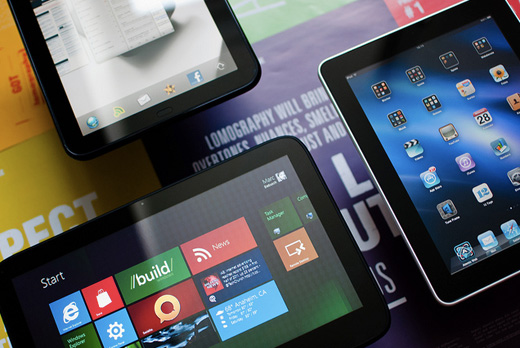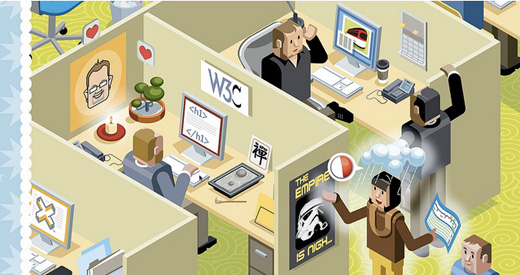Web applications displace native?
Summary In the foreseeable future, websites / web applications may force out or seriously press down native applications.
Applications can be made independently of the App Store, Android Market and others on HTML / CSS / JS.
This will be possible due to many independent factors:
1. Unfriendly ecosystem policy

Officially, you can get on iOS only through the App Store
')
Because of Apple's policy, which obliged to deduct 30 percent of revenue and decided not to share information about subscribers, The Financial Times left the App Store. Previously, The Wall Street Journal has stopped selling subscriptions through the store.
Anyway, 30% is a lot, and together with a rather large number of constantly changing restrictions, application stores are not the most pleasant thing for a developer.
If the App Store were a catalog of privileged guaranteed proven, high-quality and secure applications along with other features to get the program, then payment for such services would be justified.
But now it is the only official way for developers to bring their application to the end user. In fact, the App Store is similar to a search engine that indexes applications and makes them visible to users. But the search engine, unlike the App Store, does not charge for this very indexing.
No wonder there is an unofficial alternative repository for iOS for dissent - Cydia .
2. Too many ecosystems

According to KPCB, sales of tablets and smartphones outpaced sales of PCs and laptops in mid-2011.
In addition to problems within stores, there are difficulties in developing a large number of versions of applications to cover the entire range of stores.
In order for your application to be available to the maximum number of users, you need to make versions at least under:
- Apple iOS
- Google Android
- Windows Phone.
And then there is: - Blackberry os
- HP webOS
- Samsung bada
- Meego
- Nokia Maemo
For each of the 8 platforms have their own nuances with which you need to understand.
WebOS simplifies life by actively using familiar HTML 5, CSS and JavaScript in development. Access to the hardware of the device can be obtained using JavaScript. Cool, but it would be better to write such code for everyone at once.
And at the moment PhoneGap can be such an optimal solution. Once we do HTML, CSS and JavaScript - the output is a universal code for all stores.
Very well, the problem of universality has been solved, but the problem of independence has not been solved. You can still not find a common language with the corporation-owner and fly out of the store.
3. Access from the site to the hardware of smartphones and tablets

W3C is busy
While application stores are competing with each other, W3C is working hard to create open standards and specifications that give sites / web applications access to the hardware component of the device . It will be possible to take an image from a camera or sound from a microphone.
For example, receiving a sound from a microphone would look like this:
navigator.getUserMedia({audio: true}, gotAudio); function gotAudio(stream) { // ... use 'stream' ... } And so we get the video:
navigator.getUserMedia({video: true}, gotStream); function gotStream(stream) { // ... use 'stream' ... } This means that access to the hardware of the devices - the main plus of native applications for many developers - will be available for websites / web applications.
4. Universal and independent mobile solutions
The Boston Globe newspaper and the ISO organization have resolved the issue of the availability of content for mobile visitors using a responsive website using Responsive Web Design technology.
This site is optimally displayed both on mobile devices and on the desktop. The Responsive Web Design approach can also be used to create universal web applications for smartphones and tablets.

The Boston Globe from a mobile device
The problem is that at the moment from an adaptive site you cannot access the camera of your smartphone, your address book or sms. Don't get it yet.
Everything will change with the ubiquity of standards for access to the hardware of mobile devices, and work on this is already underway, as described in the previous paragraph.
When solving this problem, another one arises: 3G speeds may not pull sites with such functionality, but this is already solved:
5. Very fast mobile internet over LTE

LTE advertising, technology ready for commercial use
With the advent of the next-generation fast mobile network (marketing 4G) with a theoretical speed of 326.4 Mbit / s for downloading and 172.8 Mbit / s for return, the emphasis will increasingly shift from native applications towards sites and web applications.
In December 2011, Yota launched the first LTE network in Russia in Novosibirsk. And in January 2012, modems for LTE will be sold in retail .
A dozen other Russian cities are already technically ready to launch LTE. Description of why and by whom this process is artificially slowed down worthy of a separate article.
Conclusion
At the moment, you can not create a universal independent native application. Which will work on all devices and does not depend on any restrictions imposed by ecosystems.
Sites / web applications can become an output when specifications for access to the hardware will be implemented in popular devices and mobile Internet speeds will increase. For those who do not need complex functionality, and this, for example, media companies, there is already a solution in the technology Responsive Web Design .
Of course, it will take time, but once it was possible to watch videos only with the help of flash :)
Source: https://habr.com/ru/post/136070/
All Articles